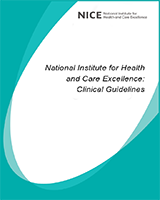From: Evidence review for patient information

NCBI Bookshelf. A service of the National Library of Medicine, National Institutes of Health.
| Field | Content |
|---|---|
| Review question | What information is useful for people with primary hyperparathyroidism? |
| Type of review question |
Views and experiences (qualitative) A review of health economic evidence related to the same review question was conducted in parallel with this review. For details see the health economic review protocol for this NICE guideline. |
| Objective of the review | To determine what information should be provided to people with PHPT. |
| Eligibility criteria – population | Adults (18 years or over) with primary hyperparathyroidism Strata:
Exclude people:
|
| Eligibility criteria – context | Any type of information described by studies.
|
| Eligibility criteria – comparator(s) | N/A |
| Outcomes and prioritisation | Synthesis of qualitative research: thematic analysis – information synthesised into main review findings. Results presented in a detailed narrative and in table format with summary statements of main review findings. |
| Eligibility criteria – study design | Qualitative studies (for example, interviews, focus groups, observations) |
| Other inclusion exclusion criteria |
|
| Proposed sensitivity / subgroup analysis, or meta-regression | N/A |
| Selection process – duplicate screening / selection / analysis | Studies are sifted by title and abstract. Potentially significant publications obtained in full text are then assessed against the inclusion criteria specified in this protocol. |
| Data management (software) | CERQual will be used to synthesise data from qualitative studies.
|
| Information sources – databases and dates |
Clinical search databases to be used: Medline, Embase, CINAHL and PsycINFO Date: all years Language: Restrict to English only Supplementary search techniques: backward citation searching Key papers: Not known |
| Identify if an update | N/A |
| Author contacts |
https://www |
| Highlight if amendment to previous protocol | For details please see section 4.5 of Developing NICE guidelines: the manual. |
| Search strategy – for one database | [For details please see appendix B |
| Data collection process – forms / duplicate | A standardised evidence table format will be used, and published as appendix D of the evidence report. |
| Data items – define all variables to be collected | For details please see evidence tables in appendix D (clinical evidence tables) or H (health economic evidence tables). |
| Methods for assessing bias at outcome / study level |
Standard study checklists will be used to critically appraise individual studies. For details please see section 6.2 of Developing NICE guidelines: the manual. The risk of bias across all available evidence will be evaluated for each outcome using an adaptation of the ‘Grading of Recommendations Assessment, Development and Evaluation (GRADE) toolbox’ developed by the international GRADE working group http://www |
| Criteria for quantitative synthesis | For details please see section 6.4 of Developing NICE guidelines: the manual. |
| Methods for quantitative analysis – combining studies and exploring (in)consistency | For details please see the separate Methods report for this guideline. |
| Meta-bias assessment – publication bias, selective reporting bias | For details please see section 6.2 of Developing NICE guidelines: the manual. |
| Confidence in cumulative evidence | For details please see sections 6.4 and 9.1 of Developing NICE guidelines: the manual. |
| Rationale / context – what is known | For details please see the introduction to the evidence review. |
| Describe contributions of authors and guarantor |
A multidisciplinary committee developed the evidence review. The committee was convened by the National Guideline Centre (NGC) and chaired by Jonathan Mant in line with section 3 of Developing NICE guidelines: the manual. Staff from the NGC undertook systematic literature searches, appraised the evidence, conducted meta-analysis and cost-effectiveness analysis where appropriate, and drafted the evidence review in collaboration with the committee. For details please see Developing NICE guidelines: the manual. |
| Sources of funding / support | The NGC is funded by NICE and hosted by the Royal College of Physicians. |
| Name of sponsor | The NGC is funded by NICE and hosted by the Royal College of Physicians. |
| Roles of sponsor | NICE funds the NGC to develop guidelines for those working in the NHS, public health and social care in England. |
| PROSPERO registration number | Not registered |
From: Evidence review for patient information

NCBI Bookshelf. A service of the National Library of Medicine, National Institutes of Health.